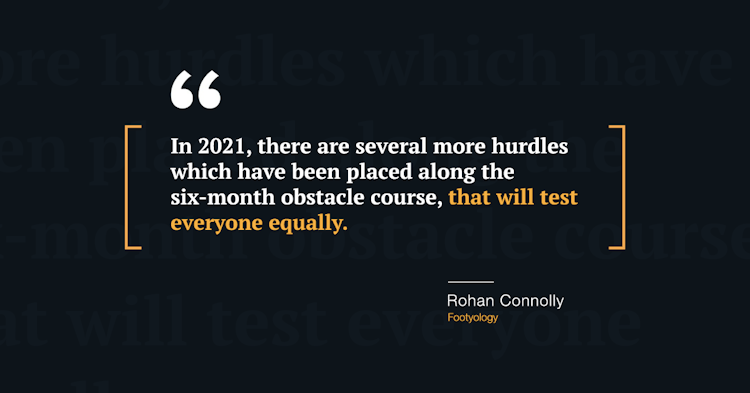The AFL’s Re-Designed Obstacle Course Makes For A Wide Open Premiership Race
Last updated: Mar 17, 2021, 1:35AM | Published: Mar 15, 2021, 2:52AM
Most new AFL seasons begin with a lot of hyperbole about hope for everyone and the great unknown. Sometimes we tend to gild the lily a little. But in 2021, I’m convinced it’s no exaggeration.
It struck me particularly last week when I sat down to compile a predicted ladder for this year.
We know these days you don’t have to be a tremendous team to make the final eight. Indeed, the odd team has made it over the years even with a negative win-loss ledger. A potential premier, however, is something else again.
RELATED: We've simulated the season 10,000 times at Stats Insider. Check out what our model is projecting
As a dedicated glass half-empty observer, I rarely, if ever, think there’s more than three or four teams capable of going all the way. Yet in 2021, I reckon there’s at least seven who if the cards fall right, can be the ones holding up the cup at the end of September. And I’m confident that’s not because I’m going soft in my old age.
There’s a couple of bona fide heavyweights who have been there year after year in Richmond and Geelong. Two more precocious upstarts in Port Adelaide and Brisbane who continue to build and have come awfully close over the last couple of years.
There’s two more experienced outfits in West Coast and the Western Bulldogs who have both tasted that flag success over the last five years, still have the nucleus of those combinations intact and firing, and, particularly in the case of the Dogs, have a solid argument that this is in fact a more capable squad than that which went all the way.
And to that half-dozen I’d add St Kilda, which continues to stockpile handy senior talent like Brad Crouch and Jack Higgins to the mix after its five imports from other clubs proved so valuable last year, and has now had a full year to fully digest and know back-to-front the philosophies and game style of coach Brett Ratten.
That’s a wide open field for the flag in a normal year. But even that usual premiership speculation aside, 2021 is looming as a season in which the game could change significantly in both appearance and key statistical indicators, which by extension means what has and hasn’t worked well in recent years may no longer be the case.
RELATED: 18 Clubs, 18 Wishes For The 2021 Season
That is because of the latest crop of rule changes. And while there’s justified cynicism about the potential impact on the game given how little difference countless other tweaks and adjustments have made over the past decade, I really think this time it’s different.
In just a couple of weeks of practice matches, there’s been some pretty compelling visual evidence (and some admittedly small statistical samples) to support that theory, most notably with the new “man on the mark rule”.
Yes, superficially, the banning of the player standing the mark from moving laterally appears draconian. But far more positively, it really does appear to have opened up the game on the inside, offering players with the ball at a stop play far more scope to kick inside towards the corridor.
That’s not only made for more open, attacking football, which looks like it really could lift those scoring rates which had slumped to a 50-year low, but more unpredictable and end-to-end football thanks to a rise in turnovers in the middle of the ground as players back themselves with the kick inboard.
I was dubious about the impact of two other changes, the dragging back of the man on the mark at kick-ins an extra five metres, and a further reduction in the interchange cap from 90 rotations to 75.
But those, too, already do seem to have made a difference. In the AAMI Series, we saw the likes of Melbourne’s Steven May more prepared to roost the ball down the middle from the kick-in to generate quick transition.
And whilst five years of a cap of 90 interchanges down from the previous 120 did little to decrease congestion and increase transition football, several coaches, like Damien Hardwick and Nathan Buckley, have already commented on the increased “fatigue factor” under the new limit of 75.
Perhaps even a marginal reduction of the interchange cap has finally taken us past the tipping point at which players really are being stretched to continue to apply the same levels of defensive pressure throughout a game. That’s another positive.
It’s also undoubtedly linked (temporarily at least) to the fact it’s been a good 18 months since any AFL player has played a full-length game, given matches were reduced by an average 20 or so minutes in the COVID-impacted 2020 season.
The other (and unhappier) legacy of the coronavirus, of course, is that AFL clubs have had to make drastic reductions to their staff numbers.
That’s not a situation anyone could brand a positive. But a clear consequence will also be that teams simply cannot be quite as well-drilled in the various game structures and techniques to hold off opposition sides. And in match circumstances which, as just explained, have already changed significantly.
RELATED: AFL 2021 Schedule Difficulty: The Good, The Bad and The Ugly
What does that all mean? I think it means that in 2021, even the very best teams like the Tigers or Cats are going to have to work harder to stay ahead of the pack.
And I think it also gives the more un-fancied clubs a better chance than usual of springing a surprise on the rest of the competition by adapting quicker and maximising an edge which may not have existed previously.
Most seasons, we’re counting only on an incremental improvement or the falling away of this team or that, to change the landscape of the AFL ladder. In 2021, however, there are several more hurdles which have been placed along the six-month obstacle course, that will test everyone equally.
That really will help even the ledger a little more. And I think that in turn potentially offers one of the most thrilling football seasons we’ve seen for some time.
ROHAN CONNOLLY'S 2021 AFL LADDER
RICHMOND
WESTERN BULLDOGS
GEELONG
WEST COAST
PORT ADELAIDE
ST KILDA
BRISBANE
SYDNEY
-------------------------
Collingwood
Fremantle
GWS
Essendon
Melbourne
Carlton
Hawthorn
Gold Coast
North Melbourne
Adelaide
*You can read more of Rohan Connolly’s work at footyology.com.au
Did you enjoy this article? Join our free mailing list to get the best content delivered straight to your inbox, or join the conversation by leaving a comment below or on the Stats Insider Twitter or Facebook page.




